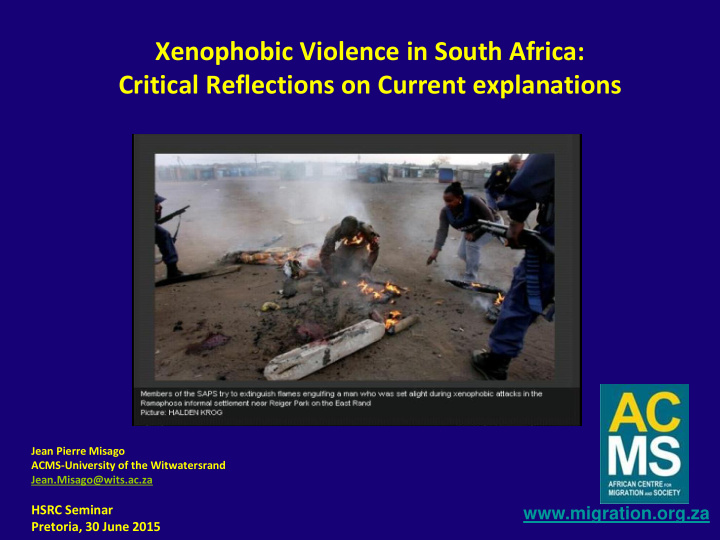



Xenophobic Violence in South Africa: Critical Reflections on Current explanations Jean Pierre Misago ACMS-University of the Witwatersrand Jean.Misago@wits.ac.za HSRC Seminar www.migration.org.za Pretoria, 30 June 2015
The African Centre for Migration & Society at Wits An internationally engaged; Africa-oriented; and African-based research and teaching centre dedicated to shaping academic and policy debates on migration, development and social transformation • Graduate degree programmes (Hons, MA, PhD) with students from across Africa, North America, and Europe; • Research in 12 African countries on issues related to migration, urbanisation, human rights, development, governance, and social change; • Partnerships in 4 continents; • Provides research services and support to government, international organizations, local NGOs, and rights advocates. www.migration.org.za
Main Arguments • Most current explanations are valuable in describing the socio-economic and political context but they fall short as scientific explanations for the occurrence of the violence • Only a multivariate explanatory model can account for all the determinants of the violence www.migration.org.za
Methods • A decade of ACMS quantitative and qualitative research; on-going • PhD work • All together, more than 30 case studies across the country (latest Soweto) Focus on explaining violence and not attitudes ‘Most similar systems’ approach to understand why violence in some areas and not in others www.migration.org.za
Conceptual clarifications • Xenophobia =/= Xenophobic violence : Violence is not a quantitative degree of conflict (Blubaker et al. 1999) • This discussion about causal explanations of xenophobic violence and not of xenophobia. • Xenophobia or just criminality? Not mutually exclusive www.migration.org.za
Current Causal Explanations: Not these…. www.migration.org.za
Current Causal Explanations: These rather…. • Can be grouped into 3 main categories: Economic and material : Competition for scarce resources and opportunities; poverty, inequality, unemployment; Service Delivery Failures; Mass Influx and Inadequate Border Control (invoking The ‘ threshold of tolerance’ hypothesis: the greater the numbers of migrants in a context of deep dislike , the more violent the reaction ( Relative deprivation theory ). Historical, political and institutional : the legacy of apartheid (segregation, isolation policies, etc.), the impact of post-apartheid nation-building efforts and the failure to meet socio-economic expectations. Psycho-social: cultural stereotyping, repressed historical trauma, culture of violence. www.migration.org.za • Shortcomings:
Current Causal Explanations: Shortcomings • Common and long standing: cannot explain violence in some areas and not in others with similar socio-economic conditions • Reductionist, one-factor, mono-causal explanations: can be at best partial or incomplete. • Biggest problem: they do not seem to recognise their limitations. They claim to be all encompassing i.e. to account for all the elements of the causal chain. What these explanations really do is to describe the conditions prevailing in affected areas; they do not explain how these conditions exactly lead to mass violence targeting foreign nationals. www.migration.org.za
Determinants of Xeno violence ( or elements of the violence causal chain ) • Deprivation: real or relative • Belief: that foreigners are the cause of the deprivation • Collective discontent towards foreigners • Micro-politics & political economy: instrumental motives of instigators • Mobilization of the discontent: the trigger • Governance and social controls: favorable opportunity structure for violence www.migration.org.za
Conclusion: Towards a Multivariate Model of Xeno Violence www.migration.org.za
Multivariate Model of Xenophobic Violence Micro - politics and Governance Political economy (intervening variable) Determinants ( intervening variable) Deprivation_______ ___ Belief__________Discontent__________________________ ____ Mobilization__________________________ ____ Xenophobic violence Instrumental motives Favourable governance of violence factors and social entrepreneur s i.e. controls provide a i nstigators’ political political opportunity and economic structure for Explanations incentives mobilizat ion to succeed in triggering violence Real or Xenophobic Belief leads to Trigger: violence Outbreak of violence as a perceived socio - attitudes and collective entrepreneurs mobilize result of value - added process : economic and belief attributing discontent and discontented members each determinant playing its political deprivation to strong of the community for specific and indispensable role deprivation foreign nationals resentment violence towards foreign nationals Elite manipulation Political theory opportunity Associated theories structure model Rational choice Greed and grievance theory Relative Scapegoating Framing Mobilization of A multivariate model deprivation model theory discontent model (my suggestion) Real conflict (my innovation ) theory www.migration.org.za
Xenophobic Violence in South Africa: Critical Reflections on Current explanations Jean Pierre Misago ACMS-University of the Witwatersrand Jean.Misago@wits.ac.za HSRC Seminar Pretoria, 30 June 2015 www.migration.org.za
Recommend
More recommend